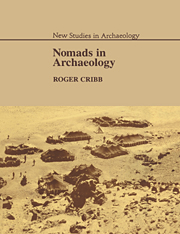Book contents
- Frontmatter
- Contents
- List of illustrations
- List of tables
- Preface
- 1 Introduction
- 2 Origins and definitions
- 3 Nomad pastoral economy
- 4 Residence, descent and territory
- 5 Nomads – the invisible culture?
- 6 Nomad architecture and domestic space
- 7 Ali's camp: a nomad household campsite
- 8 The structure and location of nomad settlements
- 9 Sariaydin Yayla
- 10 The lost world of Nemrut Daḡ
- 11 Nomad archaeology: an assessment
- 12 Towards a model of unstable settlement systems
- References
- Glossary
- Index
7 - Ali's camp: a nomad household campsite
Published online by Cambridge University Press: 23 September 2009
- Frontmatter
- Contents
- List of illustrations
- List of tables
- Preface
- 1 Introduction
- 2 Origins and definitions
- 3 Nomad pastoral economy
- 4 Residence, descent and territory
- 5 Nomads – the invisible culture?
- 6 Nomad architecture and domestic space
- 7 Ali's camp: a nomad household campsite
- 8 The structure and location of nomad settlements
- 9 Sariaydin Yayla
- 10 The lost world of Nemrut Daḡ
- 11 Nomad archaeology: an assessment
- 12 Towards a model of unstable settlement systems
- References
- Glossary
- Index
Summary
Along Turkey's southern Mediterranean coast, in the area known to classicists as Rough Cilicia (Fig. 7.1), small numbers of nomadic pastoralists continue to set up camp for the winter. During two successive autumns – 1980 and 1981–I was able to observe the comings and goings of a single household and carry out a detailed analysis of their abandoned 1980–81 campsite.
The region
The small village of Karakegi, which served as a base for much of my fieldwork, lies strewn among citrus groves, overshadowed by the battlements of a Crusader castle and the ruins of what must have been a sizeable city in Hellenistic, Roman and Byzantine times. Limestone strata rising abruptly from the sea climb tier upon tier towards the Taurus Mountains in a karst landscape heavily dissected by seasonal watercourses, faulted by massive sink holes up to 200 metres deep and drained by subterranean systems of swallow holes. Unable to retain surface water, this stony landscape has little agricultural potential except where small patches of alluvium or swampland occur at the mouths of streams. Straggly stands of winter wheat and heavily irrigated citrus orchards clothe the lower slopes. Precipitation occurs between December and May along with moderate winter temperatures, and snowfalls are almost unknown, while summer temperatures hover around 35°C.
In the Hellenistic period the region lay at the boundary of the kingdom of Olba (see Mackay 1968) whose tall stone-built watchtowers can still be seen in the hills overlooking the sea, spaced at roughly 2 kilometre intervals.
- Type
- Chapter
- Information
- Nomads in Archaeology , pp. 113 - 132Publisher: Cambridge University PressPrint publication year: 1991

